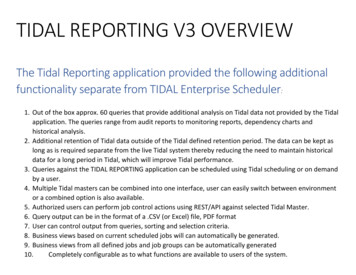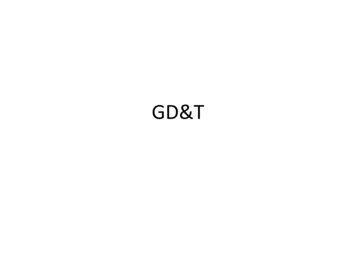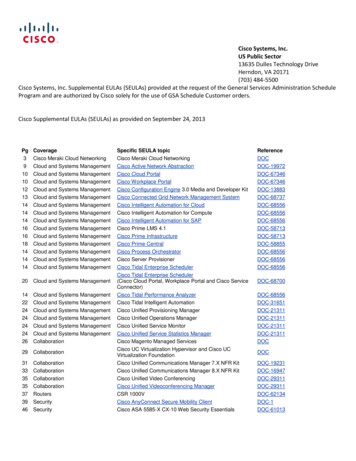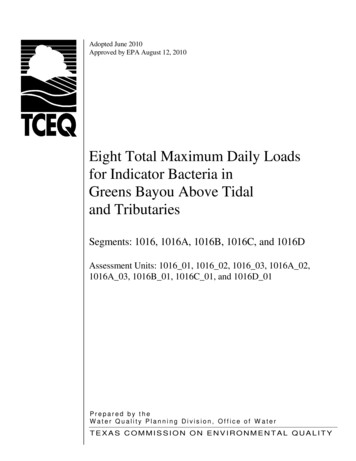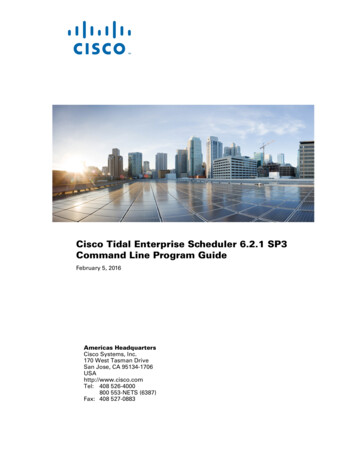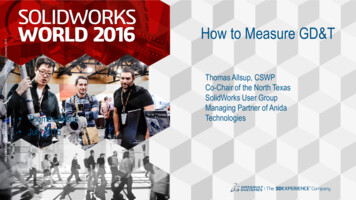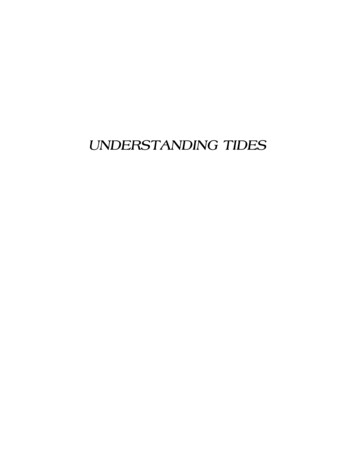
Transcription
UNDERSTANDING TIDES
UNDERSTANDING TIDESbySteacy Dopp HicksPhysical OceanographerCenter for Operational Oceanographic Products and ServicesMichael Szabados, DirectorDecember 2006U.S. DEPARTMENT OF COMMERCENational Oceanic and Atmospheric AdministrationNational Ocean Service
The author, Steacy D. Hicks viewing the William Ferrel tide-predictingmachine, the first tide predicting machine used in the United States(1885-1914). Photograph taken in early 1960s.ii
ABOUT THE AUTHORSteacy Dopp HicksMr. Hicks retired in December 1990 after 30 years of distinguishedFederal Service, 28 years of which was providing the Nation withexpertise in tides and currents. A graduate of UCLA in 1950 with a majorin meteorology, Mr. Hicks received his Masters Degree in physicaloceanography from the Scripps Institution of Oceanography of theUniversity of California in 1952. From 1952 to 1962, Mr. Hicks was anInstructor and Assistant Professor of Physical Oceanography at theUniversity of Rhode Island. Since entering the Federal Government (oldCoast and Geodetic Survey) in 1962, he has served in research positions;as Chief, Physical Oceanography Division; and Chief, PhysicalOceanographic Research Group; until assuming duties as Senior PhysicalOceanographer, all in the National Oceanic and AtmosphericAdministration (NOAA) and its predecessor organizations. He also hasbeen an Associate Professorial Lecturer in Physical Oceanography at TheGeorge Washington University. Mr. Hicks was selected a Fellow in thefirst class (1964-65) of the Department of Commerce Science andTechnology Fellowship Program. In the Program, he studied at theGeophysical Fluid Dynamics Laboratory of NOAA. Mr. Hicks is a 1970graduate of the senior resident course (College of Naval Warfare) of theU.S. Naval War College in Newport, RI. He received the Silver Medal ofthe U.S. Department of Commerce for his research on tides, long-periodsea-level variations, and tidal datums; and has authored numerous papersin refereed scientific journals on these subjects. His nine military awardsfrom WWII, while serving in the Destroyer USS Conway (DD507),include the Combat-Action Ribbon and the Asiatic-Pacific CampaignMedal with six major engagement stars.Michael SzabadosDirector,Center for Operational Oceanographic Products and Servicesiii
AcknowledgmentsI am very grateful to Michael Szabados, Director, Center for OperationalOceanographic Products and Services, for inviting me to have mymanuscript published by his organization. Brenda Via was in charge ofthe entire publishing process. Leonard Hickman, my point of contact atthe beginning, was particularly helpful in coordinating the variouselements involved. My sincere thanks to both of them for theirthoroughness on my behalf. Stephen Gill revised and expanded severalimportant sections. His expertise in the harmonic analysis and predictionof tides was invaluable. Critical reviews by Chris Zervas on long periodsea level changes and Bruce Parker on tidal theory were very muchappreciated.iv
TABLE OF CONTENTSAcknowledgments . . . . . . . . . . . . . . . . . . . . . . . . . . . . . . . . . . . . . . . .ivList of Figures . . . . . . . . . . . . . . . . . . . . . . . . . . . . . . . . . . . . . . . . . . . vii1. Introduction . . . . . . . . . . . . . . . . . . . . . . . . . . . . . . . . . . . . . . . . . . .12. Gravitational Attraction . . . . . . . . . . . . . . . . . . . . . . . . . . . . . . . . .53. The Sun-Earth and Moon-Earth Systems . . . . . . . . . . . . . . . . . . . . 7The Sun-Earth System . . . . . . . . . . . . . . . . . . . . . . . . . . . . . . . . 7Primary development . . . . . . . . . . . . . . . . . . . . . . . . . . . . . . . . . 7Alternative development . . . . . . . . . . . . . . . . . . . . . . . . . . . . . . 9The Moon-Earth System . . . . . . . . . . . . . . . . . . . . . . . . . . . . . . 9Primary development . . . . . . . . . . . . . . . . . . . . . . . . . . . . . . . . . 9Alternative development . . . . . . . . . . . . . . . . . . . . . . . . . . . . . . 104. Spring and Neap, Distance and Declination . . . . . . . . . . . . . . . . . .Spring and Neap Tides . . . . . . . . . . . . . . . . . . . . . . . . . . . . . . . .Distance . . . . . . . . . . . . . . . . . . . . . . . . . . . . . . . . . . . . . . . . . . .Declination . . . . . . . . . . . . . . . . . . . . . . . . . . . . . . . . . . . . . . . . .111114155. Tide-Generating Forces . . . . . . . . . . . . . . . . . . . . . . . . . . . . . . . . . 216. Wave Motion . . . . . . . . . . . . . . . . . . . . . . . . . . . . . . . . . . . . . . . . . 257. Tidal Waves in Gulfs and Estuaries . . . . . . . . . . . . . . . . . . . . . . . . . 29Tides in Estuaries and Bays . . . . . . . . . . . . . . . . . . . . . . . . . . . . 31Tidal Bores . . . . . . . . . . . . . . . . . . . . . . . . . . . . . . . . . . . . . . . . . 368. Tidal Harmonic Constituents . . . . . . . . . . . . . . . . . . . . . . . . . . . . . 399. Harmonic Analysis and the Prediction of Tides . . . . . . . . . . . . . . .Historical Organization . . . . . . . . . . . . . . . . . . . . . . . . . . . . . . .Harmonic Analysis . . . . . . . . . . . . . . . . . . . . . . . . . . . . . . . . . . .Prediction of Tides . . . . . . . . . . . . . . . . . . . . . . . . . . . . . . . . . . .Types of Tides . . . . . . . . . . . . . . . . . . . . . . . . . . . . . . . . . . . . . .454545474910. Tidal Datums . . . . . . . . . . . . . . . . . . . . . . . . . . . . . . . . . . . . . . . . .Tidal Datums . . . . . . . . . . . . . . . . . . . . . . . . . . . . . . . . . . . . . . .Hydrographic Surveying . . . . . . . . . . . . . . . . . . . . . . . . . . . . . .Coastal and Marine Boundaries . . . . . . . . . . . . . . . . . . . . . . . . .Early Development of Tidal Datums and Marine Boundariesin the United States . . . . . . . . . . . . . . . . . . . . . . . . . . . . . . . . . .51515354v57
Sea Level Variations . . . . . . . . . . . . . . . . . . . . . . . . . . . . . . . . . 58Chronology of Significant Tidal Events in the United States . . . . . . . 61Bibliography . . . . . . . . . . . . . . . . . . . . . . . . . . . . . . . . . . . . . . . . . . . . 65vi
LIST OF FIGURES1. Envelope of tide generating forces . . . . . . . . . . . . . . . . . . . . . . . . .82. Spring tides . . . . . . . . . . . . . . . . . . . . . . . . . . . . . . . . . . . . . . . . . . . 123. Neap tides . . . . . . . . . . . . . . . . . . . . . . . . . . . . . . . . . . . . . . . . . . . . 124. Priming . . . . . . . . . . . . . . . . . . . . . . . . . . . . . . . . . . . . . . . . . . . . . . 135. Lagging . . . . . . . . . . . . . . . . . . . . . . . . . . . . . . . . . . . . . . . . . . . . . . 146. The sun-earth system . . . . . . . . . . . . . . . . . . . . . . . . . . . . . . . . . . . 157. The moon-earth system . . . . . . . . . . . . . . . . . . . . . . . . . . . . . . . . . . 168. Diurnal inequality . . . . . . . . . . . . . . . . . . . . . . . . . . . . . . . . . . . . . . 179. Lunar node positions for diurnal inequality . . . . . . . . . . . . . . . . . . 1810. Particle trajectories of progressive wave in deep water . . . . . . . . 2611. Progressive wave transformation into shallow water . . . . . . . . . . 2612. Characteristics of a tidal wave. . . . . . . . . . . . . . . . . . . . . . . . . . . 3013. Tidal height and current relationships in a progressive tidal wave3014. Formation of standing tidal wave from reflection . . . . . . . . . . . . 3115. Tidal height and current relationships in a standing tidal wave . . 3216. Damping of a tidal wave in an estuary . . . . . . . . . . . . . . . . . . . . . 3417. Relationship of tidal waves to size of estuaries . . . . . . . . . . . . . . 3518. Propagation of a tidal bore in a river estuary . . . . . . . . . . . . . . . . 3619. Constituent tide curve example . . . . . . . . . . . . . . . . . . . . . . . . . . . 3920. Phase relationships for spring and neap tides . . . . . . . . . . . . . . . . 4121. Phase lag and amplitude for a harmonic constituent . . . . . . . . . . 4722. Coastal and marine boundaries from tidal datums . . . . . . . . . . . . 56vii
CHAPTER 1INTRODUCTIONThis book presents an elementary explanation of tides and tidaldatums. It is written to explain the natural phenomenon of tides in termsand concepts readily understandable by students as well as those in allwalks of life merely wishing to be enriched by additional knowledge oftheir environment. Also, scientists in fields other than physicaloceanography and astronomy may wish to use the book as a primer to thefundamentals of tidal theory. Although not at all essential to a completeunderstanding of tides, a mathematical development of the tide-generatingforces is provided.Chapter 10 Tidal Datums should be of particular interest to coastalzone managers, coastal engineers, geologists specializing in beachprocesses, attorneys concerned with boundary litigation, and legislators (atall government levels) representing marine activities and jurisdictionsadjacent to the sea. Finally, it is hoped that new employees in the tides andtidal datum areas of the National Oceanic and AtmosphericAdministration will find this book a very helpful introduction to theircareers.The term tide is often restricted to the vertical rise and fall of the waterusually occurring twice in a little more than a day. This rise and fall arebest observed on a breakwater or on the piles of a pier. When the water isviewed near the time of its lowest point, called low tide or low water, theextent of marine growth and discoloration indicates the general range ofthe vertical excursion. The tidal range varies, from place to place overtime, from almost nothing to many feet.With tides on a sloping beach, the water moves up the beach landwardand down the beach seaward. Similarly, but on a grander scale, it movesinland and then seaward across the sloping mud flats and marshes ofestuaries as the tide alternately rises and falls.The horizontal component of this phenomenon is called the tidalcurrent. It is best seen at an inlet connecting the ocean with a barriersound. The tidal current floods and then ebbs with slack waters inbetween. At any particular location, the high and low tides; together withthe floods, ebbs, and slacks of the tidal current; have a particular sequenceof occurrence with near constant time intervals between each other.The tide (in its restricted sense) and tidal current are both integral partsof one major phenomenon that will be called hereafter, the tide. Tides1
should be thought of as being in the form of waves. These waves arethousands of miles in length. Their crests are the high tides, their troughs,the low tides, and the horizontal component of the water particles thatmake up the wave, the tidal currents. To complicate the matter, thesewaves combine to reinforce or interfere with each other in varyingamounts, partially contributing to the wide differences in tidalcharacteristics as actually observed.The tide is fundamentally caused by gravitational interactions betweenthe sun, moon, and earth. These interactions of the gravitational forces arethe same as those causing the moon and earth to remain in their respectiveorbits.It is often said of science that the ability to predict a natural event isindicative of understanding. Since tides are one of the most accuratelypredictable natural phenomena, it follows from the axiom that the tide istruly understood. Nothing could be further from the truth. The sciences ofastronomy and geophysics provide very accurate quantitativedeterminations of the tide-generating forces on the earth. The science ofphysical oceanography provides a detailed understanding of wavedynamics and the response of the ocean to the tide-generating forces.The Center for Operational Oceanographic Products and Services(CO-OPS) of the National Ocean Service (NOS), National Oceanic andAtmospheric Administration (NOAA) provides very accuratemeasurements of the tide over time at numerous locations throughout theUnited States and its territories. But, between the fundamental tideproducing forces and the observed tide at a particular place and time, thereis a vast area of numerous unknowns that will be referred to as terrestrialfactors. Some of the factors that the unknowns are associated with are:1. the restrictive depths of the oceans not allowing the generatedtidal wave to be in equilibrium with the rotation of the earth,2. irregular ocean depths over which the waves must travel,3. reflections and interactions of the waves from irregularly shapedcontinents,4. bottom friction,5. turbulence, and6. viscosity of the water.In addition to the terrestrial factors mentioned above there are alsometeorological factors which, at some locations, cause large differencesbetween the observed and predicted tide. Weather events such as2
hurricanes and tropical storms can produce significant differences betweenpredicted and observed water levels. Wind, rain (associated with riverrunoff), and barometric pressure, even when not associated with a stormevent, can also cause major differences between observed and predictedwater levels.How is it, then, that the physical oceanographers at NOAA are able topredict the tide with great accuracy? By employing an empirical methodthe tide-generating forces can be related to the observed tide with sets ofnumerical constants unique to a particular location. Essentially, these setsof constants embody the terrestrial factors partially listed above. Withastronomical information readily available, extrapolations can be made forpredictions years in advance using the same sets of constants. Why does itwork? First, because it is correct that the tide is fundamentally caused bythe gravitational interactions between the sun, moon, and earth. Second,because the tide can be observed with great accuracy at a particularlocation over time. And third, because the earth happens to be a veryconsistent responder to these tide-generating forces, even though all theanswers associated with the processes are not known. However,incorporating meteorological factors is not feasible for predictions at thedesired degree of accuracy. Only the astronomic tides are considered inthis book.The analysis and prediction of tides are covered in the succeedingchapters. This is not for the purpose of teaching one how to predict thetides, but rather for the understanding that will be achieved in breakingdown the total system into its simple components and then recombiningthese components into the realistic ocean tide.3
CHAPTER 2GRAVITATIONAL ATTRACTIONIn the ordinary course of human experience, gravitational attractionseems to be a fundamental and universal force. It maintains the planetsand their moons in orbit and gives rise to the gravity we feel on earth.Gravitational attraction is a basic force in everyday Newtonian physics.Newtonian physics describes motion extremely well, providing the motiondoes not approach the speed of light and is not in close proximity to a verylarge body, like the sun. For example, the motion of the planet Mercury,closest to the sun, is not described perfectly by this physics. However, aswith the vast amount of observed and experienced motion, tides are bestdescribed and understood through Newtonian physics.Gravitational attraction possesses several characteristics ofconsiderable interest. It is well known that objects of differing weights fallat the same speed in a vacuum. Also, that gravitation is bidirectional. Thatis, the moon attracts the earth as the earth attracts the moon.More obscure characteristics, described thoroughly by Heyl (1954),are that observations of comets show that gravitation is not affected bychanges in temperature. Pendulum experiments with different bobs showno differences, whether made of terrestrial or meteoritic material, solid orliquid substances, radioactive or natural items, or the same substancebefore or after a chemical reaction. Similarly, crystalline items of the sameweight in any orientation and magnetized and non-magnetized substancesshow no differences.Gravitation cannot be screened either. Astronomers have looked forthe cumulative effects of minute perturbations in the orbit of the moonwhen it is directly behind the earth in a total lunar eclipse, but to no avail.Newton had no suggestion as to the fundamental cause of gravitation.Einstein related it to the warping of the space coordinate system in thepresence of large masses. The bending of starlight as it passes close to thesun is one of the verifications. An analogy, although not entirelysatisfactory, is a large weight placed in the center of a pond with a frozensurface. The weight will depress the ice such that a bowling ball, thrownat just the right speed and to just miss the weight, will revolve around it inan ellipse simulating the effect of gravitational attraction. The idea here isthat the geometric distortion of the ice is analogous to the warping of thespace coordinate system.5
Gravitational attraction is directly proportional to the product of themasses involved and inversely proportional to the square of the distancebetween the centers of mass. The square in the denominator means thatdistance becomes quite important. As will be seen in subsequent chapters,the development of the tide-generating forces involves a cube in thedenominator, making distance very important in tides.The words “tide,” as in “high tide,” and “water,” as in “high water,”have been used interchangeably in the historical development of tidalactivity here in the United States. In the last few decades, “water” hasbeen favored. Whenever ocean elevation measurements are made, thehighs and lows include the astronomic tides and all other effects such asthose caused by the winds and ocean currents. Therefore, “water” is themost appropriate term. In analyzing, studying, and predicting, however,“tide” is the most appropriate since the astronomic tide is the element thatwe are able to predict with the greatest accuracy and reliability. Recently,the term “water level tidal prediction” has been introduced by CO-OPS inan attempt to solve this semantic problem.Here, “tide” will be used throughout since the subject is astronomictides. However, “water” will be used in such terms as “mean lower lowwater” in Chapter 10 Tidal Datums. The latter use is because tidal datumsare precisely defined terms that have been recognized in law as they relateto coastal and marine boundaries (ownership, jurisdiction, and legalresponsibility).6
CHAPTER 3THE SUN-EARTH AND MOON-EARTHSYSTEMSTo best understand the tide, it is necessary to study each astronomicalmotion, together with its associated tide producing forces, separately.Furthermore, it is necessary to study each as a simple, idealized motion.Later, these separate, simple, idealized motions will be combined to forma realistic description of the astronomic phenomena and the tides forwhich they are responsible.The Sun-Earth SystemThe sun and the earth revolve around their common center of mass inone year. Although the orbits are elliptical and the earth is inclined to theecliptic (its plane of revolution around the sun), these facts are notconsidered at this time. The mean distance between the sun and the earthis about 92,897,400 miles. The center of mass of the sun-earth system islocated about 280 miles (mean) from the center of the sun. Therefore, itmight be easier to visualize the sun as wobbling around this point.Primary developmentThe tide-generating forces may be developed by consideringdifferences in the gravitational attraction of the sun at various locations onthe earth. At the center of mass of the earth the gravitational attractionmust be a value just necessary to keep the earth in its orbit around the sun.This is F2 in Figure 1. At a point on the side of the earth facing the sun, thegravitational force, F1, is greater than at the center because it is closer tothe sun. Since water is more fluid than the earth, the water distends towardthe sun. At a point on the side of the earth away from the sun, thegravitational force, F3, is less than at the center because it is further awayfrom the sun. Thus, the water distends away from the sun. Quantitatively,the tide-generating forces are the differences between the gravitationalattraction at the center of the earth and the gravitational attractions at thepoints of interest, as altered by distances from the sun.D1 F1 – F2 directed toward the sunD3 F2 – F3 directed away from the sunThe same development can be used for all points on the earth. Theends of the difference vectors, D, will form an envelope of the tidegenerating forces. It is a symmetrical egg-shaped distention that many7
Figure 1. Envelope of tide generating forcesrefer to as the tidal bulge of the ocean waters. It is not. Again, it is theenvelope of the tide-generating forces - the tide potential. It is thedistention that the tide-generating forces are trying to make in the oceanwaters but never realize because of the factors mentioned in Chapter 1,i.e., restriction of wave speed, irregular depths, presence of continents,bottom friction, turbulence, and viscosity. It is frequently referred to as theequilibrium tide.Looking down on the North Pole in Figure 1, the earth spins counterclockwise in one solar day. The mean solar day is the period of rotation ofthe earth on its own axis (spin) referenced to the mean sun and is dividedinto 24 solar hours. Starting with the point on the equator toward the sun,the point experiences a maximum in the solar tide-generating force; sixhours later, a minimum; then a maximum at twelve hours; a minimumagain at eighteen hours; and finally back to the maximum at theconclusion of the solar day. Note that in one solar day there are twocomplete tide-generating force cycles. The distended symmetrical eggshaped envelope of the tide-generating forces stays lined up with the sunas the earth and sun go around their common center of mass each year.The earth spins (slips) once within the envelope each solar day.8
Alternative developmentThe earth is maintained in its orbit around the center of mass of thesun-earth system by centripetal acceleration. Centripetal acceleration isprovided, in this case, by the gravitational attraction between the sun andearth. Centrifugal force, a fictitious or apparent force, may be introducedfor convenience. The concept of centrifugal force is derived from theinertial tendency of the earth to go flying off into space tangentially to itsorbit. When considered over 360 , it may be represented by a vectordirected away from the center of mass of the sun-earth system.Centrifugal forces are the same throughout the earth. This is realizedby remembering to take only one motion at a time and to considerirrotational motion. In irrotational motion, the earth does not spin on itsaxis even once during the year. Thus, only the revolution of the eartharound its common center of mass with the sun takes place. Therefore, anylocation on the earth has the same radius as any other and the centrifugalforces at all points on the earth are equal.Gravitational forces differ throughout the earth. The closer a point onthe earth is to the sun, the greater the force. This is because gravitationalforce varies inversely as the square of the distance between the sun andearth. Since the earth does not fall into the sun or fly off into space(significantly during historic times), the gravitational force must bebalanced by the centrifugal force (equal but oppositely directed vectors) atthe center of mass of the earth. On the side of the earth facing the sun, thegravitational force is greater than the centrifugal causing a tide producingforce directed toward the sun. On the side of the earth away from the sun,the gravitational force is less than the centrifugal causing a tide producingforce directed away from the sun.It is unimportant which of the above developments is used forunderstanding. The two ways of thinking about it are the same and yieldthe same results. However, the primary development will continue to beused for continuity.The Moon-Earth SystemPrimary developmentThe moon and the earth revolve around their common center of massin one month. Although their orbits are elliptical and the earth’s equatorand moon’s orbit are inclined to the ecliptic, these facts are not consideredat this time. The mean distance between the moon and the earth is about238,860 miles. The center of mass of the moon-earth system is locatedwithin the earth about 2895 miles (mean) from the center of mass of theearth, always toward the moon.9
Figure 1 shows the gravitational force vectors, F, and the differencevectors, D. They are essentially the same as for the sun-earth systemexcept for magnitude. The same development can be used for all points onthe earth as previously explained for the sun-earth system.Looking down on the North Pole in Figure 1, the earth spins counterclockwise in one lunar day. The mean lunar day is the period of rotation ofthe earth on its own axis referenced to the moon and is 24.84 solar hoursin length. Starting with the point on the equator toward the moon, thepoint experiences a maximum in the lunar tide-generating force; 6.21 solarhours later, a minimum; then a maximum at 12.42 solar hours; a minimumagain at 18.63 hours; and finally back to the maximum at the conclusionof the lunar day. Note that in one lunar day there are two complete tidegenerating force cycles, just as there were for the sun. However, the solarcycle took 24 hours and the lunar, 24.84. The distended symmetrical eggshaped envelope of the lunar tide-generating forces stays lined up with themoon as the earth and moon go around their common center of mass eachmonth. The earth spins (slips) once within the envelope each lunar day.Alternative developmentThe alternative development of the tide-generating forces for themoon-earth system is the same as for the sun-earth system. However, thecenter of mass of the moon-earth system is deep within the earth. Bytaking one motion at a time and considering irrotational motion, the earthwobbles around this point. Since the earth does not rotate (spin) during themonth with irrotational motion, every point on the earth describes a circleof the same radius. Visualization of the centrifugal force on the side of theearth facing the moon is difficult, at first. Irrotational motion andconsideration of only the monthly revolution are the keys. The centrifugalforce vector on the side of the earth facing the moon is directed away fromthe moon like all the other points on the earth.10
CHAPTER 4SPRING AND NEAP, DISTANCE ANDDECLINATIONSpring and Neap TidesThe range of tide, defined as the vertical difference in height betweenconsecutive high and low tides, varies from place to place and also variesover time. The combination of the solar and lunar envelopes during thesynodic month causes spring tides and neap tides. The synodic month isreferenced to the sun (or phase of moon) and is 29.530588 days in length.By combining the sun-earth system and the moon-earth system asoutlined in Chapter 3, spring and neap tides are developed. Spring tideshave nothing to do with springtime. They are tides with ranges greaterthan the average monthly range. Spring tides occur twice each synodicmonth due to the approximate alignment of the sun, moon, and earth.Neap tides are tides with ranges less than the average monthly range. Theyoccur twice each synodic month due to the sun, earth, and moon formingright angles (approximately) to each other.Colloquially, the tide is said to "follow the moon" since it is 2.16 timesmore influential than the sun in causing the tide. It is probably moredescriptive to say that the tide, in most locations, is controlled by the lunartide-generating forces as modified by the solar.When the moon is new (on the side of the earth toward the sun) or full(on the side of the earth away from the sun), the tide-generating forces ofthe sun and moon are aligned. In Figure 2, the envelope of the tidegenerating forces of the sun augments the envelope of the moon. The hightides of the solar envelope occur at the same time as the high tides of thelunar. This increases the height of the composite high tides. Likewise, thelow tides of the solar envelope occur at the low tides of the lunar. Thisdecreases the height of the composite low tides. Therefore, larger thanaverage tidal ranges occur, called spring tides.When the moon is in its first or third quarter, however, the tidegenerating forces of the sun are at right angles to those of the moon. InFigure 3, the envelope of the tide-generating forces of the sun is shown toconflict with the force envelope of the moon. The low tides of the solarenvelope occur at the times of the high tides of the lunar. This reduces theheight of the composite high tides. Likewise, the high tides of the solar11
Figure 2. Spring tidesFigure 3. Neap tides12
envelope occur at the low tides of the lunar. This increases the height ofthe composite low tides. Therefore, smaller than average tidal rangesoccur, called neap tides. The change in range between spring and neaptides amounts to about 20%.In addition to changes in tidal range, the spring-neap tide phenomenonalso causes changes in the time of occurrence of the high and low tidephases of the lunar tide. As the moon goes from new to first quarter or fullto third quarter, the solar envelope is behind the lunar such that thecomposite is retarded. Thus, as the earth spins, the high and low tidephases of the composite occur earlier than with just the lunar envelope.This is called priming. Priming is shown in Figure 4.Figure 4. Priming13
Similarly, as the moon goes from first quarter to full or third quarter tonew, the solar envelope is ahead of the lunar such that the composite isaccelerated. Thus, as the earth spins, the high and low tide phases of thecomposite envelope occur
But, between the fundamental tide producing forces and the observed tide at a particular place and time, there is a vast area of numerous unknowns that will be referred to as terrestrial factors. Some of the factors that the unknowns are associated with are: 1. the restrictive depths
